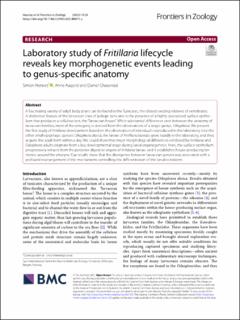| dc.contributor.author | Henriet, Simon Raymond | |
| dc.contributor.author | Aasjord, Anne | |
| dc.contributor.author | Chourrout, Daniel Marc | |
| dc.date.accessioned | 2023-03-30T12:58:45Z | |
| dc.date.available | 2023-03-30T12:58:45Z | |
| dc.date.created | 2022-11-13T13:38:26Z | |
| dc.date.issued | 2022 | |
| dc.identifier.issn | 1742-9994 | |
| dc.identifier.uri | https://hdl.handle.net/11250/3061203 | |
| dc.description.abstract | A fascinating variety of adult body plans can be found in the Tunicates, the closest existing relatives of vertebrates. A distinctive feature of the larvacean class of pelagic tunicates is the presence of a highly specialized surface epithelium that produces a cellulose test, the “larvacean house”. While substantial differences exist between the anatomy of larvacean families, most of the ontogeny is derived from the observations of a single genus, Oikopleura. We present the first study of Fritillaria development based on the observation of individuals reproduced in the laboratory. Like the other small epipelagic species Oikopleura dioica, the larvae of Fritillaria borealis grow rapidly in the laboratory, and they acquire the adult form within a day. We could show that major morphological differences exhibited by Fritillaria and Oikopleura adults originate from a key developmental stage during larval organogenesis. Here, the surface epithelium progressively retracts from the posterior digestive organs of Fritillaria larvae, and it establishes house-producing territories around the pharynx. Our results show that the divergence between larvacean genera was associated with a profound rearrangement of the mechanisms controlling the differentiation of the larval ectoderm. | en_US |
| dc.language.iso | eng | en_US |
| dc.publisher | BMC | en_US |
| dc.rights | Navngivelse 4.0 Internasjonal | * |
| dc.rights.uri | http://creativecommons.org/licenses/by/4.0/deed.no | * |
| dc.title | Laboratory study of Fritillaria lifecycle reveals key morphogenetic events leading to genus-specific anatomy | en_US |
| dc.type | Journal article | en_US |
| dc.type | Peer reviewed | en_US |
| dc.description.version | publishedVersion | en_US |
| dc.rights.holder | Copyright 2022 The Author(s) | en_US |
| dc.source.articlenumber | 26 | en_US |
| cristin.ispublished | true | |
| cristin.fulltext | original | |
| cristin.qualitycode | 1 | |
| dc.identifier.doi | 10.1186/s12983-022-00471-y | |
| dc.identifier.cristin | 2072949 | |
| dc.source.journal | Frontiers in Zoology | en_US |
| dc.identifier.citation | Frontiers in Zoology. 2022, 19, 26. | en_US |
| dc.source.volume | 19 | en_US |

